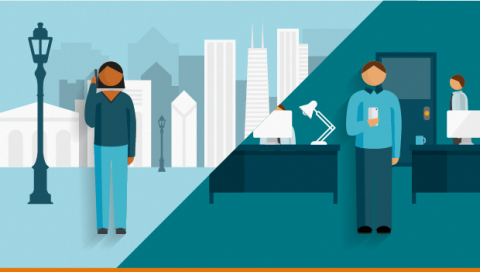Organizations are building new digital capabilities, designing new customer experiences, and transforming to meet the emerging needs of the digital world. To do this with the speed and creativity required to be successful, they are increasingly favoring the principles of agile methodology.
While this way of working was originally designed for software development, agile is being deployed across the organization. Some companies call it Agile@Scale, Scaled Agile, New Ways of Working, or some other branding – all clearly communicate to employees that there is a significant shift in how projects will be run. Other terminologies such as Tribes, Scrums, Stand-ups, Scrum-masters, etc refocus employees around structures that are team-based and deploy both specialized expertise together with domain knowledge to iterate in cycles of test and learn to develop new solutions.
[ Want to get people more comfortable with agile processes? Start to talk about it differently. See our related article, Why agile leaders must move beyond talking about "failure" ]
Regardless of the way in which Agile@Scale is implemented, new challenges are emerging as companies redesign for this way of working. Workspaces are being redesigned, new technologies are being deployed, and people are learning to work in ways that require very different skills and capabilities. While digitally-born companies like Spotify and Atlassian have lead the way in deploying Agile across the organization, larger more established companies like ANZ Bank are following suit.
In the case of ANZ Bank, it was recently reported that “It will scale its current use of agile up from 20 percent, mostly in the IT and digital teams, and split the bank's entire workforce up into autonomous, multi-disciplinary teams of about 10 employees to remove bureaucracy and hierarchies and deliver new products at speed.”
At the MIT Sloan Center for Information Systems Research, we have been studying the ways large organizations are redesigning the employee experience as they transform their business models for digital. Our findings show that companies that invest in making it easier for people to excel at their work deliver better customer experiences, more innovation, at lower costs.
These companies focus on building work environments (technologies, spaces, and social networks) that constantly adapt to the way people work rather than the other way around. They also focus on supporting their people to develop new habits to enable them to work more effectively in more innovative, collaborative work environments. Never has this been as important as it is in the world of scaled agile practices.
"We are not going agile for agile's sake. What we are trying to do is grow our speed to market, our value proposition for customers and create a more engaging environment for employees," said Katherine Bray, managing director products for ANZ Bank, in a recent interview.
[Former Department of Homeland Security CTO shares how he paved the way for agile in his recent article, When process thwarts agile development, turn the ship ]
3 ways to rethink the employee experience for Agile
Our early discussions with organizations suggest the following three challenges are occupying the minds of the leaders of Agile@Scale as they redesign the employee experience for new ways of working:
- Workspaces to empower problem-solvers : Many companies have made substantial investments in new workspaces designed to support more collaborative ways of working. However, we found in our earlier work that unless workspaces are designed as part of an integrated employee experience strategy, they provide little long-term business value. Agile brings space more to the fore of the employee experience strategy with many small agile teams (known as squads) forming around the delivery of new offerings and capabilities. Co-locating squads can be challenging both in more traditional spaces, but also in newly renovated spaces not designed for this degree of flexibility. Adaptive workspaces with more mobile workspace components are becoming increasingly important to meet the rapidly changing needs of squads and tribes.
- Virtual technologies to support speed and agility: While agile ways of working are by definition more co-located with stand-ups, transparent and displayed processes, and increased requirements for constant collaboration, many large organizations are not designed this way. Team members are often in multiple locations, have flexible work arrangements to enable people to work from anywhere, and work across multiple time zones. Designing for virtual communication is required to support coaching of squads, knowledge sharing across and within tribes, the visualization of all aspects of the product development process, and complex discussions as squads fail and pivot ideas through multiple iterations. Technologies set up simply for verbal and simple visual exchange are falling short of the more nuanced communication requirements for Agile@Scale.
- Leading the direction, not the course: Leaders in companies working in more agile ways find that the company is constantly evolving as they learn more about balancing the increased autonomy of tribes and squads with the strategic mission of the business. In other words, leaders need to set the vision and then let their people get on with it. Leaders of large traditional companies have to trade the familiar world of command and control of pre-agreed deadlines, for one much less predictable where problem solvers are empowered to deliver a solution with no clear agreement on what the outcome might even look like. This more creative, iterative process is very challenging for traditional corporate leaders. As large organizations scale, agile workplaces have to support very different leadership work habits – data is more freely shared, work is more transparent, and a wider range of people participate in decision-making in very non-traditional ways.
Kristine Dery will be speaking on this topic “Redesigning the Digital Workplace for Agile@Scale” at the 2018 MIT CIO Symposium in Cambridge, Massachusetts on May 23. For more information or to register to attend the Symposium, please click here.
[ See our top book recommendations from MIT Press and MIT CIO Symposium speakers, then enter our contest for a chance to win a book ]






